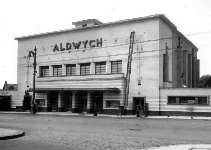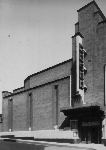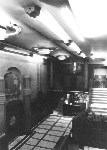New Design Directions: the Aldwych and Cosmo
 |
The Aldwych in Cardonald (1938) for Smith and Welsh was rather more
austere and abandoned streamlining altogether in favour of a savvier
look rather closer in spirit to mainstream modernism. Essentially, it
was a gigantic rendered box tied tight by a deep cornice of a size and
proportion to comprehend the auditorium within.
Alas, the Aldwych was
something of a white elephant (in every sense) as its 2,500 seats were
rather superfluous to Cardonald’s needs (it was already served by
two existing cinemas). |
Moreover, it was a middle-class outer suburb
which was barred from showing the latest releases until they had
already played in the city centre and inner suburbs. After the Second
World War, residents in such areas were among the first to equip
themselves with televisions.
Singleton acquired the Smith and Welsh cinemas in 1950 (the two firms
had always co-operated closely) and all were re-named Vogue. The
former-Aldwych was demolished for a supermarket in 1964.
James McKissack’s final cinema design was also his firm’s
masterpiece. Opened in May 1939 as the city centre flagship of the
Singleton circuit, the
Cosmo was the largest and the only purpose built
'art house’ in Britain outside London's West End.
By then McKissack’s health was failing (he died in 1940), and so
the Cosmo was actually drawn up by a younger assistant, W.J. Anderson.
The idea for a continental cinema came from Charles Oakley, a polymath
Devonian who lectured at Glasgow University. Oakley was devoted to the
city. He was a founder member of the Glasgow Film Society (formed in
1929 and thus having a claim to being the world's first), which
specialised in screening the foreign films to which he was so devoted.
When 'talkies' came along the mainstream cinemas tended to show only
English language films, pushing out even the high quality European
ones. The Cosmo set out to put matters right. Moreover, while an
independent cinema operator like Singleton could easily obtain
sufficiently up-to-date British and American films to show in his big
suburban cinemas, in the city centre, there was greater competition and
the ‘first run’ cinemas belonging to Paramount, Gaumont and
ABC showed the newest releases.
|
 |
Thus, the Cosmo plugged a gap in the
market where there was no direct competition. The name was derived from
'Cosmopolitan', a small cinema associated with Cambridge University,
with which Oakley was familiar. Singleton, whose interest in the
venture was more business like, insisted that a catchy five letter name
was needed.
The Cosmo's geometric brown brick facade was clearly influenced by the
Curzon, an upmarket art cinema in London built in 1934 designed by
Francis Lorne of Burnet, Tait and Lorne – a highly respected
Glasgow firm that also had a substantial London office. The Curzon was
a building of elegant simplicity. Its neatly detailed brick frontage
was partly the result of fierce opposition to a cinema opening in the
heart of Mayfair and it had to be less than thirty-five feet.
 |
The Curzon, in turn, was inspired by the work of Willem Dudok. As town
architect of Hilversum in the Netherlands between 1920 and 1935, Dudok
successfully solved the problem of creating visual integrity in large
public buildings. His brick clad structures were conceived as series of
massed cubic volumes playing off each other and were often topped by a
central tower feature. His designs were obvious models for cinema
architects.
Built on an awkward sloping sight on Rose Street, near Sauchiehall
Street, the Cosmo was similarly well proportioned. Clad in Ayrshire
brick finished with faience cornices, detailed in cream and amber, and
set on a base of black Swedish granite, the cinema’s facade was
as much an expression of internationalism as its programmes. Since
the planners insisted that the Cosmo be set back from the adjacent
frontages an extravagant large canopy and sign were fitted to advertise
its presence. |
Inside, the international theme was continued with a
globe over the stalls entrance in the two storey high foyer. The
vestibule was panelled in walnut. Two suites of offices, including a
directors' room, were provided. Following the maxim that audiences
would expect and appreciate fine surroundings the streamlined
auditorium had neutral and pink toned walls, which flowed in a series
of subtle curves towards the proscenium. There were satin curtains and
indirect lighting to create an air of ‘seductive
sophistication’. 'Entertainment for the Discriminating' was its
trademark.
In 1974 the Cosmo was bought by the Scottish Film Council to become the
Glasgow Film Theatre. It was subdivided into a 404-seat cinema in the
former balcony and a conference cum exhibition space in the stalls. In
1988, a 144-seat cinema replaced the conference room and later a bar
(now known as Café Cosmo) was added. The Glasgow Film Theatre is
now independently owned and makes a significant and unique contribution
to the cultural life of Glasgow and the West Coast of Scotland.